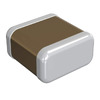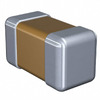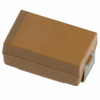[{1 1}]
2025-04-01
5884
Outline:
1. What is a variable capacitor?
2. How does a variable capacitor work?
3. Types of variable capacitors
4. What are the advantages and disadvantages of air dielectric variable capacitors and solid dielectric variable capacitors?
5. Application areas
6 Conclusion
What is a Variable Capacitor?
A variable capacitor is a capacitor that you can adjust its capacitance within a certain range. You can change its capacitance mechanically or electronically to adjust its electrical performance in a circuit for specific needs.
How does a Variable Capacitor Work?
Variable capacitors operate by adjusting the spacing between conductive plates, leading to changes in the dielectric constant and capacitance. The electric field causes the plates to move, changing the capacitance when a voltage is applied. Removing the voltage rearranges the conductive particles, reducing capacitance.
In practical applications, you can combine multiple variable capacitors on a single shaft to create coaxial variable capacitors (commonly known as dual, triple, or even multi-gang capacitors).
Types of Variable Capacitors
We can classify variable capacitors based on the dielectric material used into air dielectric capacitors and solid dielectric capacitors.
Air Dielectric Variable Capacitors
Air capacitors utilize air as the dielectric material. You can design them as either fixed or variable capacitors. People prefer variable capacitors because they are simple, but they don't often use fixed ones because there are better options available.
Air capacitors typically consist of two sets of semi-circular metal plates separated by air. The operator rotates the component to adjust capacitance, with one set fixed and the other connected to a shaft. The plates have the highest capacitance when they overlap a lot, and the lowest capacitance when they don't overlap. We employ gear reduction mechanisms to enhance capacitance control, fine-tuning, and accuracy.
Additionally, air capacitors have lower capacitance values, ranging from 100pF to 1nF, and operate within voltage ranges of 10 to 1000V. The dielectric's breakdown voltage is relatively low, which means there's a risk of internal breakdown, potentially leading to malfunctions. They are important tools for controlling capacitance in different applications. Their design, construction, and operation are crucial for electronic systems to function properly, even though they have lower capacitance values.
Solid Dielectric Variable Capacitors
Solid dielectric variable capacitors use mica sheets or thin films as the material between movable and fixed metal plates. Transparent plastic makes up the housing.
The structure of solid dielectric capacitors primarily includes single-sealed, double-sealed (rotor, stator, and dielectric assembly rotate coaxially), and double-sealed quad configurations (four sets of rotor, stator, and dielectric).
Solid dielectric variable capacitors are more stable and durable than traditional ones, as they use solid materials as dielectrics. They are suitable for various electronic devices. They have specific characteristics and functions that you can select and apply in circuits based on specific requirements.
Pros and Cons of Air Dielectric and Solid Dielectric Variable Capacitors
Air Dielectric Variable Capacitors:
Pros:
Variable capacitors excel in high-temperature conditions due to air dielectrics, making them apt for heated environments. They're resistant to aging, promising longevity. Using air also means environmental safety and suitability for green applications. Plus, they're cost-effective compared to sophisticated dielectrics.
Cons:
Air dielectric capacitors have a narrower capacitance range than solid dielectric ones, possibly limiting their use where varied capacitance is needed. They're also sensitive to humidity and temperature variations, affecting performance and stability. Additionally, air capacitors are typically larger, posing challenges in space-constrained applications.
Solid Dielectric Variable Capacitors:
Pros:
Solid dielectrics in capacitors bolster stability and reliability, showing less environmental impact. Their compact size suits space-scarce applications. With low power needs, they're ideal for battery-operated devices, prolonging battery life and enhancing efficiency. These capacitors afford meticulous control of capacitance, vital for fine-tuning RF circuits, filters, and oscillators. Precision in voltage or current input translates to exact adjustments in frequency response.
Cons:
Solid dielectric capacitors often come with lower rated voltages than their air counterparts, constraining them in high-voltage scenarios. They're also more vulnerable to damage from overvoltage, potentially affecting durability. Moreover, unlike air capacitors, they don't allow for manual tuning, narrowing their application scope.
Application Areas
Air Dielectric Variable Capacitors:
Radio tuners utilize air variable capacitors for frequency adjustments, allowing users to alter resonance and select stations.
In RF transmitters, these capacitors fine-tune circuits and link power to antennas for enhanced efficiency.
Oscillators, particularly LC types, leverage air capacitors to regulate oscillation frequencies. Antenna tuners also rely on them for matching impedance and ensuring optimal power transfer.
Solid Dielectric Variable Capacitors:
Solid dielectric variable capacitors are favored in high-frequency scenarios, especially microwave circuits. They're integral in:
1. Precise RF tuning: Essential for RF circuits demanding meticulous adjustments.
2. RF Filters: Employed to fine-tune filter frequency and bandwidth.
3. High-Q Resonant Circuits: Chosen for resonant circuits and filters requiring a high Q factor.
4. Medical Technology: Utilized in RF and microwave medical devices for their precision.
5. Aerospace and Defense: Incorporated in communication and radar systems within these sectors.
The air versus solid dielectric debate boils down to frequency, precision, and environment. Air capacitors excel in lower frequencies, while solid dielectrics shine at higher frequencies and demand greater precision.
Conclusion
Variable capacitors, essential for circuits needing tunable capacitance, come with either air or solid dielectrics. The choice hinges on specific application requirements—frequency, voltage, size, environment. Engineers carefully consider these factors to select the most suitable capacitor for a given application.
That covers all the content of this article. If you have any questions, feel free to contact us. YIC will reply to you promptly.
 FAATATAU IA TATOU
Tagata faamalieina i taimi uma.Agaalofa ma le talitonuina ma fiafia masani.
FAATATAU IA TATOU
Tagata faamalieina i taimi uma.Agaalofa ma le talitonuina ma fiafia masani.
suʻega suʻega.O oloa aupito pito sili ona maualuga tau ma le tautua sili o lo tatou tautinoga faavavau.
![[{1 1}]](/upfile/blog/small_2023111609391911391.jpg) [{1 1}]
[{1 1}]
2023-11-09
![[{1 1}]](/upfile/blog/small_2023111514522294361.jpg) [{1 1}]
[{1 1}]
2023-11-09
VAI VAEGA Numera
 GRM0335C1H221JA01D
GRM0335C1H221JA01D C0603C0G1E3R3C030BG
C0603C0G1E3R3C030BG GRM0335C1E9R1DA01D
GRM0335C1E9R1DA01D 06031A2R2C4T2A
06031A2R2C4T2A 08052A220FAT2A
08052A220FAT2A 1206CC103JAT1A
1206CC103JAT1A EMK325BJ226MM-TR
EMK325BJ226MM-TR TACL335M006R
TACL335M006R TAJD158M002RNJ
TAJD158M002RNJ MMSZ5242B-7-F
MMSZ5242B-7-F
- A8654KLPTR-T
- VI-263-IU
- MMZ2012R601AT000
- XPC850DSLZT50BU
- MAX1904EAI+T
- RT0402BRD07220RL
- VI-810087
- MC74AC08DTR2
- XA6SLX45T-2FGG484Q
- TSB41AB2IPAP
- TLV2362IPWRG4
- DS14C335MSAX
- MC100LVEL16DG
- FDS2572
- PIC16F18455-I/SS
- MC44603AP
- ADM1066ASUZ-REEL7
- ZMOD4410AI1V
- ADSP-BF561SBBZ600
- 71M6543G-IGT
- AT25320TI-10TI-2.7
- AT80251G2D-UM
- MAX6510AUT
- S29GL032A90TFIR40
- STM692ADS6E
- SY100EL16VCKCTR
- M4081H0HA15J68M0
- PS8223BQFN46GTR
- QL16X24B-0PF100C
- R27V3252J-091
- S1ZBL20A
- SII8240BOTR
- WPCT200AA0WG
- ICM7555MTV/HR
- UPD89084S1-001-B6-A
- MAX4690EWE+T
- BCM7418YKFEBA47G
- EM639325BK-5H
- DP2HDMM2MB